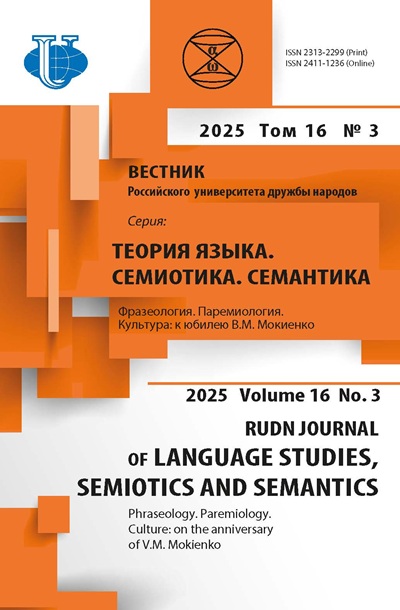Перевод с linguafranca в условиях перевода в Евросоюзе
- Авторы: Беднарова-Гибова К.1
-
Учреждения:
- University of Prešov
- Выпуск: Том 8, № 1 (2017)
- Страницы: 148-157
- Раздел: СТАТЬИ
- URL: https://journals.rudn.ru/semiotics-semantics/article/view/15620
- DOI: https://doi.org/10.22363/2313-2299-2017-8-1-148-157
- ID: 15620
Цитировать
Полный текст
Аннотация
Эта концептуальная публикация рассматривает английцский язык как lingua franca в наднациональной переводческой традиции Евросоюза путем определения переводческих особенностей институционных юридических текстов ЕС. С учетом специфики языковой и переводческой базы проблемы эквивалентности, терминологической (не-) конгруентности, природы источников текста и институирования перевода обсуждаются с целью привлечения внимания к особенностям переводческих практик, существующих в странах Евросоюза. Применяя синоптико-интерпретационный подход, автор выявляет различные способы понимания дискурса Евросоюза и переводческих практик.
Об авторах
Клаудиа Беднарова-Гибова
University of Prešov
Email: klaudia.gibova@gmail.com
Institute of British and American Studies, Faculty of Arts ul. 17 Novembra, Prešov, 1, Slovak Republic, 080 01
Список литературы
- Bednárová-Gibová K. (2015).Towards an Understanding of EU Translation (Habilitation thesis). Prešov, Faculty of Arts of the University of Prešov.
- Biel L. (2014). Lost in the Euro-Fog. The Textual Fit of Translated Law. Frankfurt am Main, Peter Lang.
- Doczekalska A. (2005). Production and Application of Multilingual Law. The Principle of Equality of Authentic Texts and the Value of Subsequent Translation. Paper read at Language and the Law 2005: East Meets West.
- Dollerup C. (2004). The vanishing original. In: Hermes. Journal of Linguistics. No. 32. P. 185-199.
- Engberg J. (2015). Autonomous EU Concepts: Fact or Fiction? In: S. Šarčević (ed.). Language and Culture in EU Law: Multidisciplinary Perspectives. Ashgate Publishing Ltd. P.169-181.
- Felici A. (2015). Translating EU Legislation from a Lingua Franca: Advantages and Disadvantages. In: S. Šarčević (ed.). Language and Culture in EU Law: Multidisciplinary Perspectives. Ashgate Publishing Ltd. P. 123-140.
- Frame I. (2005). Linguistic oddities in the European Union legislation: don´t shoot the translator. In: Clarity. Journal of the international association promoting legal language. No 53. P. 21-24: http://clarity-international.net/journals/53.pdf.
- Gardner J. (2013). Brief List of Misused English Terms in EU Publications. Luxembourg, European Court of Auditors,
- Gibová K. (2010). O preklade anglických právnych textov EÚ. Lingvisticko-translatologická analýza [On Translation of EU English Legal Texts. A Linguistic-Translational Analysis] Prešov, Vydavateľstvo Prešovskej university.
- Jenkins J. (2009). World-Englishes. A Resource Book for Students. 2nd ed. London, Routledge.
- Joint Practical Guide (2013): http://eur-lex.europa.eu/content/pdf/techleg/joint-practical-guide-2013-en.pdf.
- Kjaer A.L. (2015). Theoretical Aspects of Legal Translation in the EU: The Paradoxical Relationship between Language, Translation and the Autonomy of EU Law. In: S. Šarčević (ed.). Language and Culture in EU Law: Multidisciplinary Perspectives. Ashgate Publishing Ltd. P. 169-181.
- Koller W. (1992). Einführung in die Übersetzungswissenschaft. Heidelberrg and Wiesbaden, Quelle & Meyer.
- Koskinen K. (2000). Institutional Illusions. Translating in the EU Commission. In: The Translator. Vol. 6. No. 1. P. 49-65.
- Koskinen K. (2008). Translating Institutions. An Ethnographic Study of EU Translation. Manchester, St. Jerome Publishing.
- Künnecke M. (2013). Translation in the EU: Language and Law in the EU´s Judicial Labyrinth. In: Maastricht Journal of European and Comparative Law. Vol. 20. No. 2. P. 243-260: http: //www.maastrichtjournal.eu/pdf_file/its/mj_20_02_0243.pdf.
- McAuliffe K. (2009). Translation at the Court of Justice of the European Communities. In: Translation Issues in Language and Law. New York, PalgraveMacmillan. P. 99-115.
- Pym A. (2010). Exploring Translation Studies. London and New York, Routledge.
- Ramos F.P. (2014). International and supranationallaw in translation: from multilingual lawmaking to adjudication. In: The Translator. Vol. 20. No. 3. P. 313-331: http://dx.doi.org/10.1080/13556509.2014.904080.
- Robertson C. (2012). The Problem of Meaning in Multilingual EU Legal Texts. In: International Journal of Law, Language & Discourse.Vol. 2. No 1. P. 1-30.
- Sandrini P. (1999) Translation zwischen Kultur und Kommunikation: Der Sonderfall Recht. In: P. Sandrini (ed.). Übersetzen von Rechtstexten. Fachkommunikation im Spannungsfeld zwischen Rechtsordung und Sprache. Tübingen, Gunter Narr. P. 9-43.
- Schäffner C. and Adab B. (1997). Translation as intercultural communication - Contact as conflict. In: Translation as Intercultural Communication. Amsterdam/Philadelphia, John Benjamins. P. 325 -338.
- Sosoni V. (2010) A Hybrid Translation Theory for EU Texts. In: Vertimo Studijos. Vol. 5. P. 76-89.
- Šarčević S. (1997) New Approach to Legal Translation. Hague, Kluwer Law International.
- Šarčević S. (ed.) (2015) Language and Culture in EU Law: Multidisciplinary Perspectives. Ashgate Publishing Ltd.
- Trosborg A. (1997) Translating hybrid political texts. In: A. Trosborg (ed.). Text Typology and Translation. Amsterdam, John Benjamins. P. 145-158.
Дополнительные файлы












